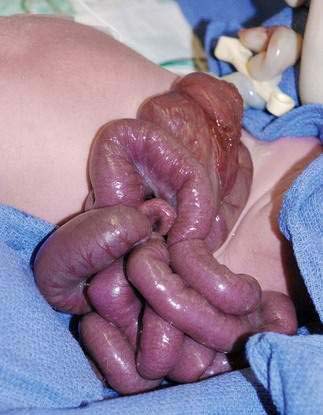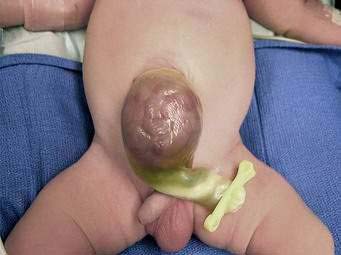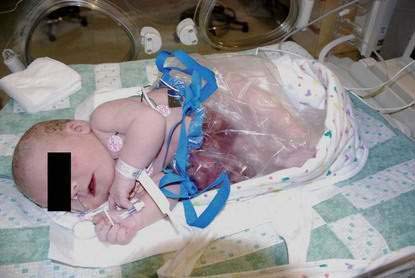CHAPTER 25 Gastroschisis and Omphalocele
Step 1: Surgical Anatomy
♦ Gastroschisis results from an anterior abdominal wall defect with herniation of the abdominal viscera into the amniotic sac. The defect is always to the right of the umbilicus and is generally 2 to 3 cm in diameter (Fig. 25-1).
♦ Omphalocele is a consequence of a central abdominal wall defect, which unless ruptured, is covered by a membrane. These defects can be small (1 to 2 cm), also referred to as hernias of the cord, or large and involving most of the abdominal wall and including the liver. Defects can be seen with associated cloacal exstrophy and also with sternal defects, such as in the case of pentalogy of Cantrell (Fig. 25-2).
Step 2: Preoperative Considerations
Gastroschisis
♦ Infants born with gastroschisis are often premature and are more likely than those with omphaloceles to have an associated intestinal atresia (14% vs. 1%). Although association with other significant abnormalities is uncommon, careful evaluation of the newborn is necessary.
♦ Initial assessment of the bowel is essential to ensure adequate perfusion without volvulus. Placing the infant in a lateral position can be helpful in preventing the mesentery from kinking as the bowel exits the abdomen.
♦ The infant should be placed in a “organ bag” with warm normal saline to protect the bowel and minimize evaporative fluid loss (Fig. 25-3).
♦ Infants with gastroschisis are often dehydrated and should receive at least 125% of normal maintenance fluids. These infants should receive broad-spectrum intravenous antibiotics and have a nasogastric tube placed for gastrointestinal decompression.
Omphalocele
♦ Infants with omphalocele frequently have associated anomalies (cardiac and renal), chromosome abnormalities (trisomy 13-15 or 16-18), or recognizable associated syndromes (Beckwith-Wiedemann, pentalogy of Cantrell, caudal regression).
♦ The sac should be kept moist either with warm, soaked gauze covered by transparent plastic wrap or through the use of an “organ bag.” They should have nasogastric decompression and receive broad-spectrum intravenous antibiotics and fluid resuscitation.
Step 3: Operative Management
Gastroschisis
♦ During preparation and prepping, care should be taken to maintain the infant’s temperature by using both a warm operating room and, when possible, warm prep solutions.
Stay updated, free articles. Join our Telegram channel

Full access? Get Clinical Tree





